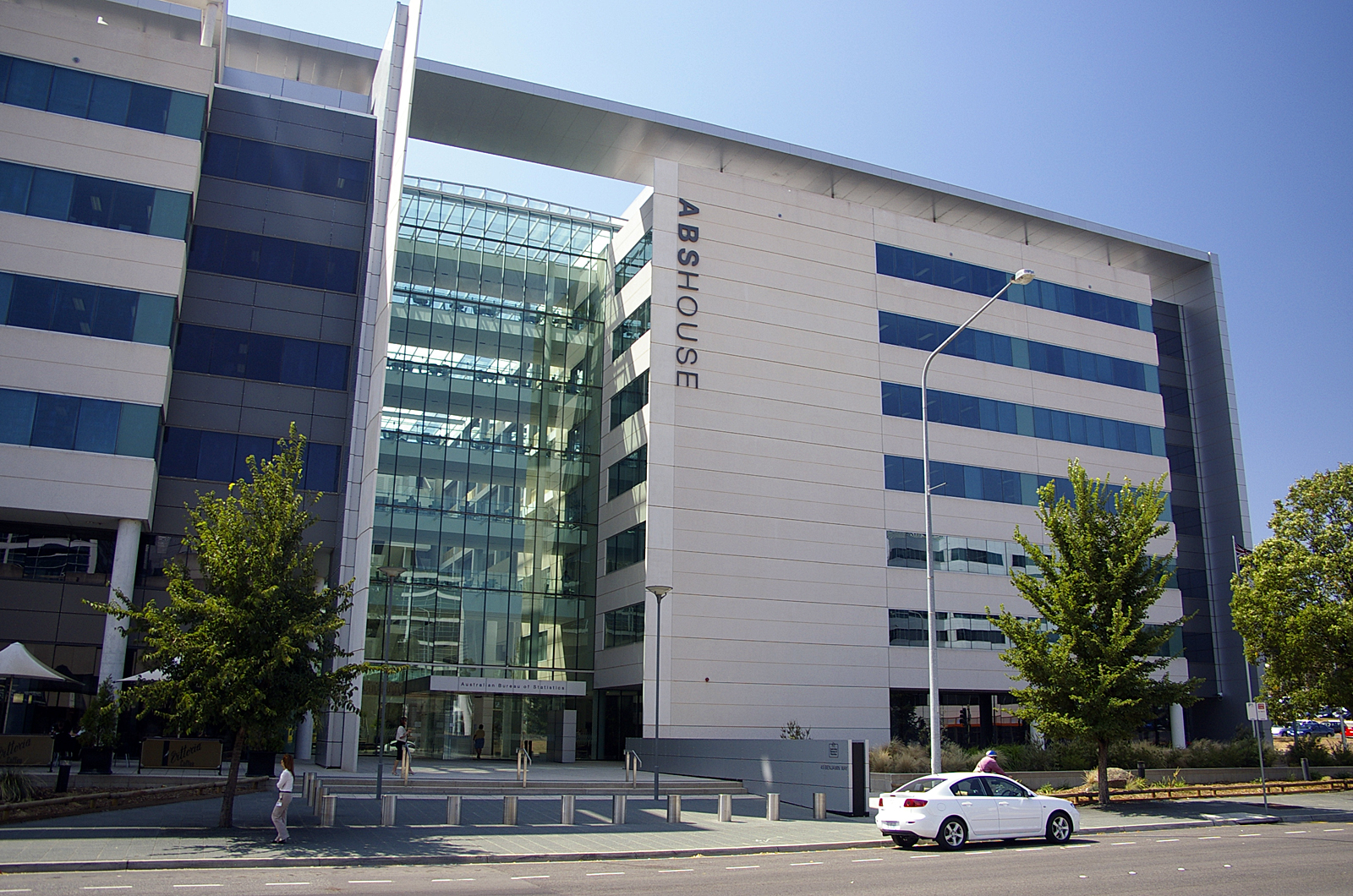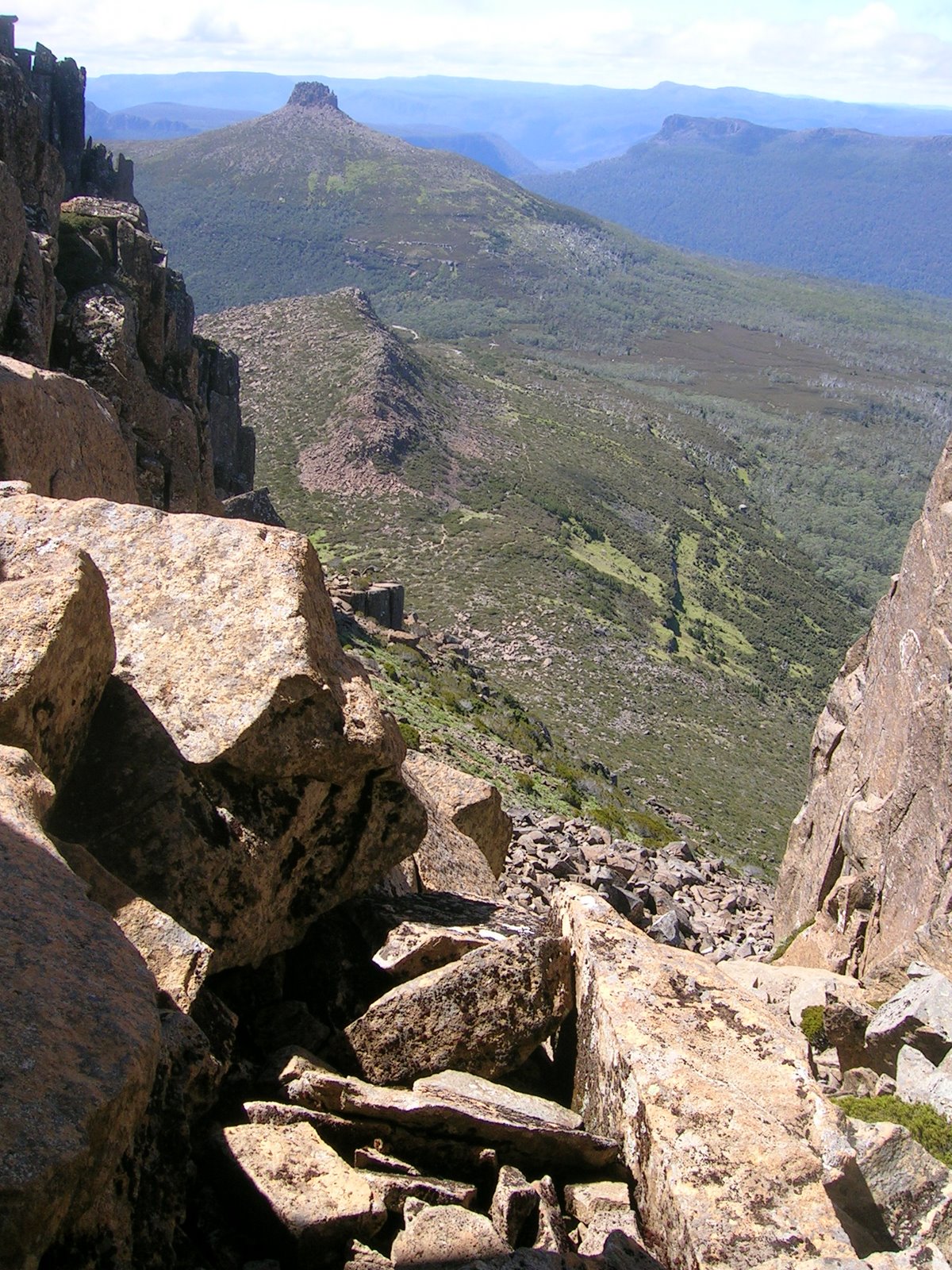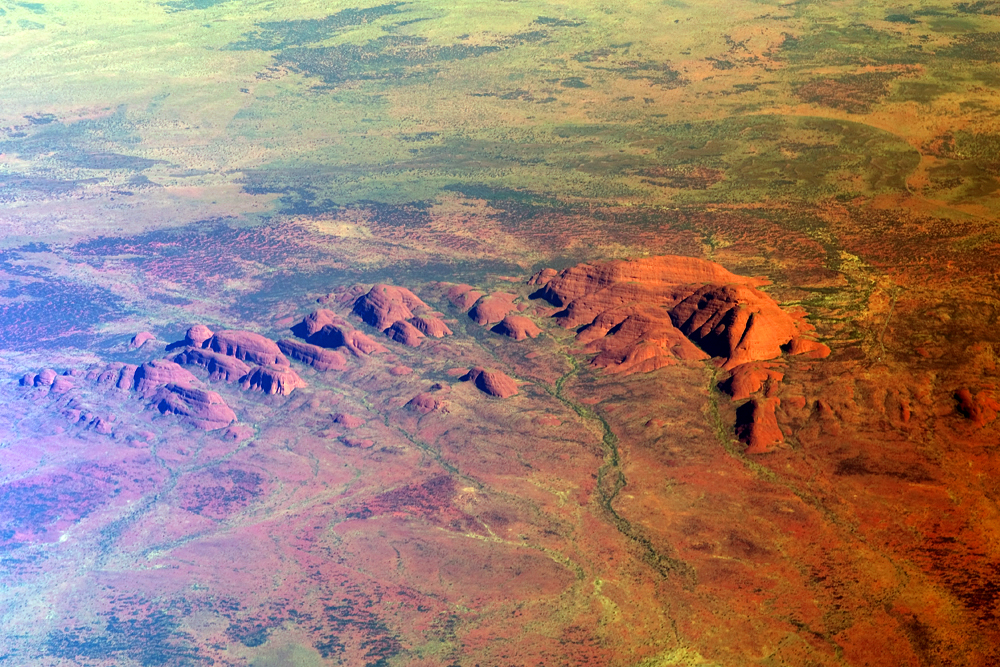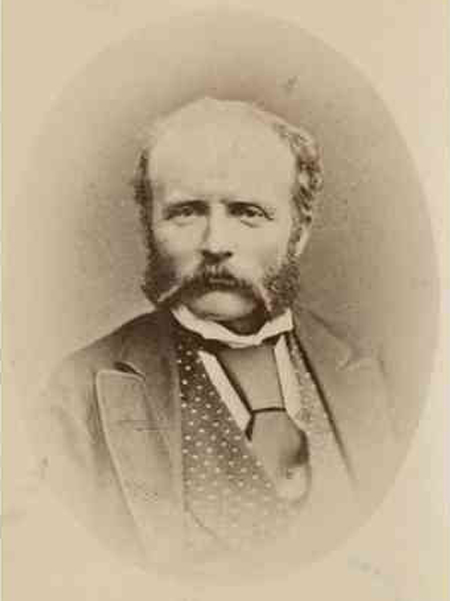|
Mount Unapproachable
Mount Unapproachable is an isolated mountain in the Northern Territory of Australia located in the locality of Petermann on the northern side of Lake Neale in the territory's southwest. It is about above sea level. The area is remote: the nearest towns are Kaltukatjara some away, Kintore some away and Yulara away. The mountain is mostly made of sandstone. Unapproachable was named by the explorer Ernest Giles in 1872, whilst on an expedition across central Australia. He had just sighted and named Lake Amadeus, and could see the mountain rising to the west. He hoped to find water at the mountain, but was unable to approach it, as his path was blocked by the lake. Giles in fact over-estimated the size of Lake Amadeus and missed the bridge of land between Amadeus and Lake Neale. In 1889, Giles' second-in-command, William Tietkens, returned on his own expedition to survey the area. In his journal, Tietkens wrote that he first travelled to the Bloods Range, to the south of Lake ... [...More Info...] [...Related Items...] OR: [Wikipedia] [Google] [Baidu] |
Petermann, Northern Territory
__NOTOC__ Petermann is a locality in the Northern Territory of Australia located about south of the territory capital of Darwin in the territory’s south-western corner adjoining the states of South Australia and Western Australia. The locality consists of the following land (from west to east) – the Petermann Aboriginal Land Trust, the Katiti Aboriginal Land Trust and the NT Portion 1798 (better known as the Uluru-Kata Tjuta National Park), the Land Settlement Aboriginal Corporation and NT Portion 6665 (better known as the Watarrka National Park), the Urrampinyi Iltjiltjarri Aboriginal Land Trust and the pastoral leases of Curtin Springs, Angas Downs and Mulga Park. The locality fully surrounds the communities of Kaltukatjara and Mutitjulu, and the locality of Yulara. Petermann is named after the Petermann Ranges, a mountain range partly located within the locality’s boundaries, and which was named after the German cartographer, August Heinrich Petermann by the ... [...More Info...] [...Related Items...] OR: [Wikipedia] [Google] [Baidu] |
Bloods Range
Bloods Range (or Blood's Range) is a mountain range in central Australia, stretching roughly east to west across the border between the Northern Territory and Western Australia. It consists of several sets of hills, separated by valleys; the two main valleys are formed by the Hull and Docker Rivers. There are numerous ravines and gorges all throughout the hills. Bloods Range connects with the Petermann Ranges at its western end. In the centre are Mounts Harris (840 m) and Carruthers (1000 m), which are the highest peaks. Further east, the range splits into several branches, including the Rowley Range, McNichol's Range and the Pinyinna Range. Bloods Range was given its name on 14 March 1874 by the explorer Ernest Giles, when he sighted it from the top of Mount Curdie. He named it for his friend John Henry Smyth-Blood (died 1890) of Beltana, owner of an early pastoral station and pioneer on the OT line. On 12 June 1889, Giles' second-in-command, William Tietkens, returne ... [...More Info...] [...Related Items...] OR: [Wikipedia] [Google] [Baidu] |
Nature (journal)
''Nature'' is a British weekly scientific journal founded and based in London, England. As a multidisciplinary publication, ''Nature'' features peer-reviewed research from a variety of academic disciplines, mainly in science and technology. It has core editorial offices across the United States, continental Europe, and Asia under the international scientific publishing company Springer Nature. ''Nature'' was one of the world's most cited scientific journals by the Science Edition of the 2019 '' Journal Citation Reports'' (with an ascribed impact factor of 42.778), making it one of the world's most-read and most prestigious academic journals. , it claimed an online readership of about three million unique readers per month. Founded in autumn 1869, ''Nature'' was first circulated by Norman Lockyer and Alexander Macmillan as a public forum for scientific innovations. The mid-20th century facilitated an editorial expansion for the journal; ''Nature'' redoubled its efforts in ... [...More Info...] [...Related Items...] OR: [Wikipedia] [Google] [Baidu] |
Australian Bureau Of Statistics
The Australian Bureau of Statistics (ABS) is the independent statutory agency of the Australian Government responsible for statistical collection and analysis and for giving evidence-based advice to federal, state and territory governments. The ABS collects and analyses statistics on economic, population, environmental and social issues, publishing many on their website. The ABS also operates the national Census of Population and Housing that occurs every five years. History In 1901, statistics were collected by each state for their individual use. While attempts were made to coordinate collections through an annual Conference of Statisticians, it was quickly realized that a National Statistical Office would be required to develop nationally comparable statistics. The Commonwealth Bureau of Census and Statistics (CBCS) was established under the Census and Statistics Act in 1905. Sir George Knibbs was appointed as the first Commonwealth Statistician. Initially, the bureau ... [...More Info...] [...Related Items...] OR: [Wikipedia] [Google] [Baidu] |
List Of Mountains Of The Northern Territory
This is a list of mountains in Australia. Highest points by state and territory List of mountains in Australia by topographic prominence This is a list of the top 50 mountains in Australia ranked by topographic prominence. Most of these peaks are the highest point in their areas. Australian Capital Territory The following is a list of mountains and prominent hills in the Australian Capital Territory in order, from the highest peak to the lowest peak, for those mountains and hills with an elevation above : New South Wales Queensland South Australia Tasmania Victoria Western Australia * Carnarvon Range * Mount Augustus (1105m) * Mount Beadell * Darling Range ** Mount Dale ** Mount Cooke * Hamersley Range ** Mount Meharry (at 1,249 metres above sea level, the highest peak in Western Australia) ** Mount Bruce (1,221 m; the second highest peak in WA) ** Mount Nameless/Jarndunmunha 1,115 m * Wunaamin Miliwundi Ranges, formerly King Leopold Ranges ... [...More Info...] [...Related Items...] OR: [Wikipedia] [Google] [Baidu] |
Herbert Basedow
Herbert Basedow (27 October 1881 – 4 June 1933) was an Australian anthropologist, geologist, politician, explorer and medical practitioner. Basedow was born in Kent Town, South Australia. His early education was in Adelaide, South Australia and Hanover, Germany. After finishing his schooling, Basedow studied science at the University of Adelaide where he majored in geology. Basedow later completed postgraduate studies at several European universities and undertook some medical work in Europe. During his working life, Basedow took part in many major geological, exploratory and medical relief expeditions to central and northern Australia. On these expeditions, he took photographs and collected geological and natural history specimens and Aboriginal artefacts. Basedow was one of the few people of his time involved in recording the traditional life of Aboriginal Australians.Kaus, David. ''A Different Time: The Expedition Photographs of Herbert Basedow 1903-1928'', Na ... [...More Info...] [...Related Items...] OR: [Wikipedia] [Google] [Baidu] |
Donald George Mackay
Donald George Mackay CBE (29 June 187017 September 1958) was an Australian outdoorsman, long-distance cyclist, and explorer who conducted several expeditions to the remotest areas of the Australian continent. Early life Donald George Mackay was born on 29 June 1870 at Yass, New South Wales, son of Alexander Mackay, owner of Wallendbeen station, and his wife Annie. Mackay was educated at Wallendbeen Public School and at Oaklands School, Mittagong. After a brief engineering apprenticeship he worked for his father until the latter's death in 1890. During 1890-99 Mackay travelled extensively abroad, and later prospected for gold in western New South Wales. Cycling expedition around Australia In July 1899 Mackay belatedly joined brothers Alex and Frank White to become the first men to travel around the continent of Australia on a bicycle. Mackay's 24-in. frame, 29 lb. ''DUX'' bicycle was especially strengthened to carry Mackay's weight plus his gear, which included two water cans ... [...More Info...] [...Related Items...] OR: [Wikipedia] [Google] [Baidu] |
Tomkinson Ranges
The Tomkinson Ranges is a mountain range in the northwest corner of South Australia. The range consists of sandstone hills, surrounded by spinifex grasslands. The range was named after politician Samuel Tomkinson (1816–1900) by the explorer William Gosse in the early 1870s. Ernest Giles and his team reached the ranges shortly after, and established a base from which to explore the Gibson and Great Victoria Deserts. Numerous prospecting expeditions were made through the region until the 1930s. Together with the Mann Ranges, the Tomkinson Ranges are an important part of the Aṉangu Pitjantjatjara Yankunytjatjara lands. The communities of Kalka Kalka is a town in the Panchkula district of Haryana, India. It is near Panchkula city. The name of the town is derived from the Hindu goddess Kali. It is situated in the foothills of the Himalayas and is a gateway to the neighbouring state ... and Pipalyatjara are located at the base of the mountains. References Mountain ... [...More Info...] [...Related Items...] OR: [Wikipedia] [Google] [Baidu] |
Petermann Ranges (Australia)
The Petermann Ranges are a mountain range in central Australia. They run across the border between Western Australia and the southwest corner of the Northern Territory. Their highest point is above sea level. The range was formed about 550 million years ago during the Petermann Orogeny. The existing geological research has broadly determined that the ''Petermann Ranges'' were equivalent in height to the Himalayas. The Petermanns were named for the geographer August Heinrich Petermann by Ernest Giles, the first European explorer to visit the area, and are commonly associated with the Yurliya ranges, nearby to the west. The area was included in the Katiti-Petermann Indigenous Protected Area in 2012. In popular culture There are few geology-oriented documentaries that trace Uluru and Kata Tjuta Kata Tjuṯa / The Olgas ( Pitjantjatjara: , lit. 'many heads'; ) is a group of large, domed rock formations or bornhardts located about southwest of Alice Springs, in the southe ... [...More Info...] [...Related Items...] OR: [Wikipedia] [Google] [Baidu] |
Kata Tjuṯa
Kata Tjuṯa / The Olgas (Pitjantjatjara: , lit. 'many heads'; ) is a group of large, domed rock formations or bornhardts located about southwest of Alice Springs, in the southern part of the Northern Territory, central Australia. Uluṟu / Ayers Rock, located to the east, and Kata Tjuṯa / The Olgas form the two major landmarks within the Uluṟu-Kata Tjuṯa National Park. The park is considered sacred to the Aboriginal people of Australia. The 36 domes that make up Kata Tjuṯa / Mount Olga cover an area of are composed of conglomerate, a sedimentary rock consisting of cobbles and boulders of varying rock types including granite and basalt, cemented by a matrix of coarse sandstone. The highest dome, Mount Olga, is above sea level, or approximately above the surrounding plain higher than Uluṟu). [...More Info...] [...Related Items...] OR: [Wikipedia] [Google] [Baidu] |
Mount Harris
Mount Harris, also named Boundary Peak 156, is a mountain in Alaska and British Columbia, located on the Canada–United States border in the Takhinsha Mountains. In 1923 ''Boundary Peak 156'' was named Mount Harris in honour of D. R. Harris, a surveyor in the Canadian section of the Boundary Survey. See also *List of Boundary Peaks of the Alaska-British Columbia/Yukon border A ''list'' is any set of items in a row. List or lists may also refer to: People * List (surname) Organizations * List College, an undergraduate division of the Jewish Theological Seminary of America * SC Germania List, German rugby union ... References Harris, Mount Mountains of Haines Borough, Alaska Harris, Mount Harris, Mount Canada–United States border International mountains of North America {{YakutatAK-geo-stub ... [...More Info...] [...Related Items...] OR: [Wikipedia] [Google] [Baidu] |
William Tietkens
William Harry Tietkens (30 August 1844 – 19 April 1933), known as "Harry Tietkens", explorer and naturalist, was born in England and emigrated to Australia in 1859. Tietkens was second in command to Ernest Giles on expeditions to Central Australia in 1873 and on a journey from Beltana, South Australia to Perth, Western Australia in 1875. In 1889 Tietkens led his own expedition west of Alice Springs to the vicinity of the Western Australian border. This expedition discovered Lake Macdonald, the Kintore Range, Mount Leisler, Mount Rennie, the Cleland Hills, defined the western borders of Lake Amadeus, and photographed Uluru (Ayers Rock) and Kata Tjuta (Mount Olga) for the first time. The expedition collected new species of plants and rock samples allowing the South Australian government geologist to compile a 'geological sketch' of the country traversed. Tietkens was elected a fellow of the Royal Geographical Society on his return. Specimens of 250 plant species were collec ... [...More Info...] [...Related Items...] OR: [Wikipedia] [Google] [Baidu] |






